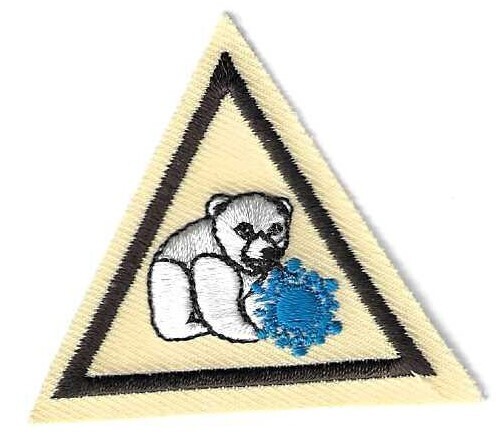Climate Change Va Skyline Council own Brownie Badge (Original)
Requirements
Complete the starred activity and five others of your choice.
ITSCOOL Education: Participate in the ITSCOOL to Light Up the World Learning and Action Program by participating in the ITSCOOL education and doing the ITSCOOL booklet activities.
ITSCOOL CFL Sale: Participate in the ITSCOOL to Light Up the World Compact Fluorescent Light Bulb Sale and help teach your community about global warming.
*Climate Basics: Learn the following terms and the difference between them: weather, climate, climate change, and global warming. Find out about the Intergovernmental Panel on Climate Change and why they earned the Nobel Peace Prize in 2007.
Story Discovery: Read a storybook about climate change and discuss the basic content. Below is a list of suggested books, which are all available for checkout from Girl Scouts of Virginia Skyline Council. • A Clean Sky: The Global Warming Story, Robyn C. Friend and Judith Love Cohen, 2007 • Down-to-Earth Guide to Global Warming, Laurie David and Cambria Gordon, 2007 • Global Warming Alert! (Disaster Alert!), Richard Cheel, 2007 • Global Warming: The Threat of Earthʼs Changing Climate, Laurence Pringle, 2003 • Global Warming (What If We Do Nothing?), Neil Morris, 2007
Whoʼs Who in the Work Place? Research careers involved with climate change. This could include scientists, community environmental groups, or policymakers. Invite someone involved with climate change to speak with your troop directly or through a conference call.
Ice Core History: Did you know that one of the ways scientists understand climate change is by looking at ice cores? Learn about ice cores and how scientists can discover information about temperature and pollution thousands of years ago. Did you know that tree rings also give you similar information? Look at a tree ring to make predictions about the climate several years ago.
Advocate for Change: Research how your community should work to reduce climate change. Write a letter to the mayor, senator, congressional representative, school principal, governor, etc., about what was discovered and how they should help.
Take Action: Learn about alternative forms of energy ̶ solar, wind, hydro, and geothermal electricity ̶ and teach several younger girls about them. How are they better for the environment? You can use posters, the Internet, books, and other materials to help.
Energy Hog or Energy Saver? Estimate how much electricity you use in your day-to-day life. You can do this by looking at the backs of appliances to see how many “watts” they use and figuring out how long you use each appliance: the more watts and the longer an item is used, the more electricity it uses. Consider experimenting with a Watts Up? meter (available at the Girl Scouts of Virginia Skyline Council office), which can directly measure how much electricity you use. How can you work to use less electricity in your daily life? How does electricity use relate to climate change?
Pledge to Make a Difference: Take the official Girl Scout Climate Change Junior Pledge (coming soon). Learn about each action of the pledge, sign it, and submit it to Girl Scouts of the USA.
Climate Change Action Guide: Complete a suggested Junior climate change activity from the Girl Scout Climate Change Action Guide (coming soon). Optional: Substitute several activities from the guide for other requirements.
